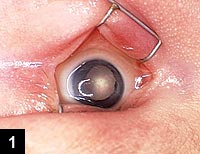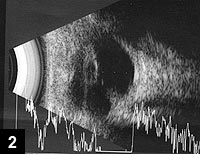Consultation sought for newborn girl with leukocoria
Ectropion uveae, congenital cataract and dense retrolental fibrovascular plaque were observed in the infant’s left eye.

 Isabel M. Balderas |  Tom Hsu | ||
The pediatric ophthalmology service at the New England Eye Center was consulted on a 1-day-old infant girl who was found to have leukocoria of the left eye on routine newborn screening. The newborn was born full-term to a primigravid mother with an uncomplicated pregnancy and vaginal delivery. At birth, the newborn weighed 7 lbs, 13 oz (3,544 g) and was otherwise healthy. Family history was notable for a maternal history of inactive toxoplasmosis in the left eye.
Examination
Anterior segment exam revealed white, quiet conjunctiva of the left eye (Figure 1). The left cornea was noticeably smaller in diameter than the right cornea. We noted ectropion uveae along with a congenital cataract and dense retrolental fibrovascular plaque in the left eye. There was no view to the posterior pole of the left eye. The right anterior and posterior segment exams were normal. B-scan ultrasound of the left eye revealed a stalk extending to the lens and no apparent intraocular tumor or retinal detachment (Figure 2).
 Anterior segment photo, left eye. |  B-scan ultrasound, left eye. Images: Strominger MB, Chang J | |

What is your diagnosis?
Leukocoria
The differential diagnosis for a newborn with leukocoria includes retinoblastoma, persistent fetal vasculature (persistent hyperplastic primary vitreous), retinopathy of prematurity, congenital cataract, chorioretinal colobomas, uveitis, toxocariasis and Coats’ disease, among others.
Retinoblastoma is a life-threatening condition that must be ruled out in all cases of leukocoria. The presence of microcornea and congenital cataract makes retinoblastoma less likely. Retinoblastoma does not typically present at birth. Ninety percent of retinoblastoma cases are diagnosed before the child is 3 years of age, and the average age at diagnosis of unilateral retinoblastoma is approximately 24 months. Ultrasound is a helpful adjunct tool and did not demonstrate any intraocular mass lesions or calcifications. Stage 5 (total retinal detachment) retinopathy of prematurity can present with leukocoria, but it is rare in infants with birth weight greater than 2,000 g.
Persistent fetal vasculature (PFV), also known as persistent hyperplastic primary vitreous (PHPV), is a congenital, usually unilateral, isolated malformation of the eye. Bilateral cases can be associated with systemic or neurologic abnormalities. Ocular abnormalities range from mild (prominent hyaloid vessel remnants, Bergmeister papillae, Mittendorf dot) to severe (microphthalmia with angle-closure glaucoma, retinal detachment and phthisis). Our patient was diagnosed with PFV based on clinical and B-scan examination findings.
Discussion
Treatment for PFV includes observation for mild cases and severe cases with minimal potential for improvement of visual acuity. Surgical intervention and postoperative amblyopia therapy are chosen for vision-threatening cases with the potential for improvement in vision. Surgery involves clearing the visual axis with lensectomy, partial or total retrolental fibrovascular membrane removal, and posterior capsulectomy. Depending on the results of the surgery and the patient’s age, either an IOL is implanted or the patient is left aphakic and corrected with contact lenses or spectacles.
The techniques used in cataract surgery for infants with PFV are markedly different than those used in adult cataract surgery. Excision of retrolental fibrovascular membranes is associated with a high rate of intraoperative and postoperative complications. Intraocular hemorrhage, pupillary block, glaucoma, ciliary body and retinal traction, and membrane recurrence can all occur. For removal of PFV-associated retrolenticular membranes, an anterior transpupillary or posterior pars plana or pars plicata approach can be utilized.
Our patient is scheduled for surgery at age 1.5 months to allow more time for the eye to mature. Pars plana lensectomy, vitrectomy, membrane excision and posterior capsulectomy are planned due to the dense retrolental fibrovascular membrane encompassing the posterior surface of the lens and ciliary body.
For more information:
- Jeffrey Chang, MD, and Mitchell B. Strominger, MD, can be reached at New England Eye Center, Tufts University School of Medicine, 750 Washington St., Box 450, Boston, MA 02111; 617-636-4219; fax: 617-636-4866; Web site: www.neec.com.
- Edited by Isabel M. Balderas, MD, and Tom Hsu, MD. Drs. Balderas and Hsu can be reached at New England Eye Center, Tufts University School of Medicine, 750 Washington St., Box 450, Boston, MA 02111; 617-636-4219; fax: 617-636-4866; Web site: www.neec.com. Drs. Balderas and Hsu have no direct financial interest in the products mentioned in this article, nor are they paid consultants for any companies mentioned.
References:
- Alexandrakis G, Scott IU, et al. Visual acuity outcomes with and without surgery in patients with persistent fetal vasculature. Ophthalmology. 2000;107(6):1068-1072.
- Dawson DG, Gleiser J, et al. Persistent fetal vasculature. Arch Ophthalmol. 2003;121(9):1340-1341.
- Lundvall A, Zetterström C. Primary intraocular lens implantation in infants: Complications and visual results. J Cataract Refract Surg. 2006;32(10):1672-1677.
- Müllner-Eidenböck A, Amon M, et al. Surgery in unilateral congenital cataract caused by persistent fetal vasculature or minimal fetal vascular remnants: Age-related findings and management challenges. J Cataract Refract Surg. 2004;30(3):611-619.
- Paysse EA, McCreery KM, Coats DK. Surgical management of the lens and retrolenticular fibrotic membranes associated with persistent fetal vasculature.J Cataract Refract Surg. 2002;28(5):816-820.
